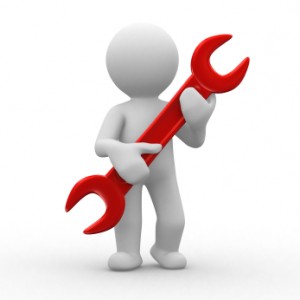Posted by Teresa on December 8, 2011 under Landlord Paperwork and Forms | 
 If you’re like most landlords, you want to keep your investment properties in good shape. A well-maintained property appraises well, attracts quality tenants, can help you avoid liability issues and will save you money in the long run.
If you’re like most landlords, you want to keep your investment properties in good shape. A well-maintained property appraises well, attracts quality tenants, can help you avoid liability issues and will save you money in the long run.
Establishing a maintenance and repairs policy and setting up procedures that are clearly understood by your tenants and your maintenance person or company (even if that’s you!) can go a long way toward making this aspect of owning rental property much easier.
Rental Property Maintenance Procedures May Include:
- A regular inspection schedule, such as quarterly, set in advance, and preceded by 48-hour notice (or whatever your state requires);
- Keeping a tenant request tracking system or log to make sure that safety and other issues are handled within a reasonable time frame;
- Notifying tenants of repair and maintenance policies when they apply for a lease, at lease signing, and throughout the year;
- Providing tenants with several maintenance report forms to use throughout their lease term;
- Establishing a response time for each category of tenant complaints: safety, emergency, routine, etc.;
- Contact information for maintenance problems that are reported during the day, after hours, or on holidays.
Rental Property Maintenance Policies Typically Specify:
- Tenant responsibilities: changing light bulbs (for safety), and promptly reporting safety hazards like loose floorboards or railings, blown fuses, clogged plumbing and electrical problems.
- Landlord responsibilities: repairing hazards immediately, replacing air filters regularly, checking heating systems annually, responding to tenant complaints within a reasonable (stated) time frame and providing a safe, habitable residence for tenants.
Maintaining your rental property and responding promptly to tenant requests are vitally important to your business. In some cases, tenants may be entitled to withhold rent if maintenance issues are not addressed. And you never want to be responsible for a health problem or injury that occurs due to improper maintenance or repairs.
Posted by Teresa on February 20, 2009 under General, Landlord Tips | 
If you’re a typical rental property owner, you’ve invested a great deal of money and sweat equity in your property: the initial purchase price, interest and taxes, ongoing repairs and improvements, plus dozens of incidental costs associated with owning any property. Protect your investment with a sound inspection policy and schedule.
The law requires that you properly maintain your property to meet all applicable health and safety codes (check your state and local laws and statutes for specifics). While it is certainly in your best interest to comply with the law and keep your property in top condition, it benefits your tenants, too. The good feelings that come with living in a safe, well-maintained home are valuable assets, and go a long way toward retaining high quality tenants.
Poorly maintained properties lead to higher tenant turnover, operating losses and even potential legal problems and expenses. Why take the risk?
Consider presenting new tenants with a Property Inspection Schedule, along with the lease, when they move in—or make it part of their Welcome Package. Either way, expectations are established right up front. Well-informed tenants could be more likely to keep small issues from becoming major hassles and repairs, too—saving you money in the long run.
What should the schedule include?
-
A checklist of items that will be inspected, for example: electrical, heating, and plumbing systems, smoke detectors, water heater, door and window locks;
-
A target date for each quarterly or semi-annual inspection, with a notice that you will contact tenants two weeks prior to arrange a convenient time;
-
Areas to detail any observed damages or needed repairs to systems, walls, ceilings, floors, roof, and landscaping;
-
Your contact numbers;
-
Date, time, and signature lines—to be signed by you and everyone listed on the lease.
Take photos of any damaged areas for your records. Let your tenants know when you will return to the property to make repairs—and what they can do to prevent the problem in the future.
Remember to keep a positive attitude throughout the inspection—the purpose is to keep everyone in compliance and safe. It is within your rights, however, to hold the tenant financially responsible for damages caused by negligence or misuse of your property.
Find landlord resources, including everything you need to know about tenant screening, from E-Renter.com.
Next post: Companion Animals and the Americans with Disabilities Act (ADA)
 If you’re like most landlords, you want to keep your investment properties in good shape. A well-maintained property appraises well, attracts quality tenants, can help you avoid liability issues and will save you money in the long run.
If you’re like most landlords, you want to keep your investment properties in good shape. A well-maintained property appraises well, attracts quality tenants, can help you avoid liability issues and will save you money in the long run.